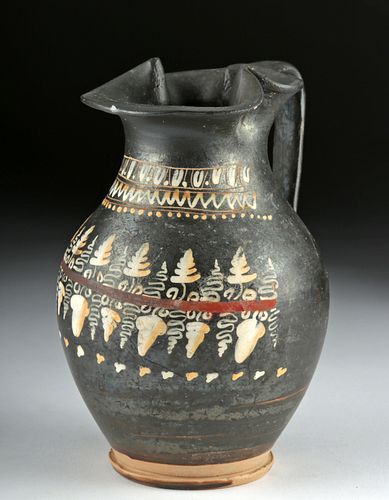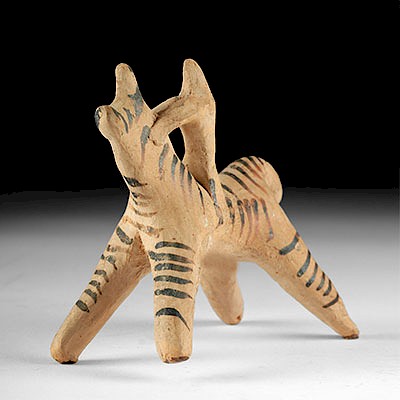Greek Gnathian Trefoil Oinochoe - Grapevine Decoration
Lot 38
About Seller
Artemis Fine Arts
686 S Taylor Ave, Ste 106
Louisville, CO 80027
United States
Selling antiquities, ancient and ethnographic art online since 1993, Artemis Gallery specializes in Classical Antiquities (Egyptian, Greek, Roman, Near Eastern), Asian, Pre-Columbian, African / Tribal / Oceanographic art. Our extensive inventory includes pottery, stone, metal, wood, glass and textil...Read more
Estimate:
$800 - $1,200
Absentee vs Live bid
Two ways to bid:
- Leave a max absentee bid and the platform will bid on your behalf up to your maximum bid during the live auction.
- Bid live during the auction and your bids will be submitted real-time to the auctioneer.
Bid Increments
| Price | Bid Increment |
|---|---|
| $0 | $25 |
| $300 | $50 |
| $1,000 | $100 |
| $2,000 | $250 |
| $5,000 | $500 |
| $10,000 | $1,000 |
| $20,000 | $2,500 |
| $50,000 | $5,000 |
| $100,000 | $10,000 |
| $200,000 | $20,000 |
About Auction
By Artemis Fine Arts
Oct 25, 2018
Set Reminder
2018-10-25 11:00:00
2018-10-25 11:00:00
America/New_York
Bidsquare
Bidsquare : Antiquities from Egypt, Greece, Italy, Asia
https://www.bidsquare.com/auctions/artemis-gallery/antiquities-from-egypt-greece-italy-asia-3538
Featuring Egyptian, Greek, Roman, Etruscan, Near Eastern, plus Asian art from Central and Far East. If you love the classics, this is the sale for you. Artemis Fine Arts info@artemisgallery.com
Featuring Egyptian, Greek, Roman, Etruscan, Near Eastern, plus Asian art from Central and Far East. If you love the classics, this is the sale for you. Artemis Fine Arts info@artemisgallery.com
- Lot Description
Magna Graecia, southern Italy, near present day Ignazia, ca. 340 to 320 BCE. An attractive blackware pottery pitcher with a trefoil spout decorated via the Gnathian technique with fugitive red, white, and yellow pigments - depicting an elaborate grapevine pattern around the body, punctuated by a band of tiny laurel buds below, with egg and dart, zigzag, and beaded bands adorning the shoulder - separated by incised lines. Contributing further to its beautiful decorative program is the silvery iridescence that the black glaze has attained over the ages. Size: 4.125" W x 6.25" H (10.5 cm x 15.9 cm)
Gnathia ware is named for the site where it was first discovered - the Apulian site of Egnathia. The black glaze ware is traditionally decorated with floral motifs in red, white, or yellow hues. Scholars believe that its production most likely was centered around Taras, with primary workshops in Egnathia and Canosa. The quantity and quality of Greek colonial Apulian potters increased significantly following the Peloponnesian War when Attic exports dramatically decreased. Apulian artistry demonstrates influences of Ionian (Athenian, Attic) conventions, as well as Doric (western colonial Greek) styles, with a palpable native Italian aesthetic.
Provenance: private East Coast, USA collection
All items legal to buy/sell under U.S. Statute covering cultural patrimony Code 2600, CHAPTER 14, and are guaranteed to be as described or your money back.
A Certificate of Authenticity will accompany all winning bids.
We ship worldwide and handle all shipping in-house for your convenience.
#140234Rim and handle have been repaired and reattached with restoration over the break lines and some repainting. A small surface chip to the lower body. Tiny nicks to the edges of the spout. Two diagonal impressions to the shoulder - likely created when the piece was made. Painted program is in an excellent state. The black glaze has developed a gorgeous silvery iridescence.Condition
- Shipping Info
-
All shipping is handled in-house for your convenience. Your invoice from Artemis Gallery will include shipping calculation instructions. If in doubt, please inquire BEFORE bidding for estimated shipping costs for individual items.
-
- Buyer's Premium



 EUR
EUR CAD
CAD AUD
AUD GBP
GBP MXN
MXN HKD
HKD CNY
CNY MYR
MYR SEK
SEK SGD
SGD CHF
CHF THB
THB
















